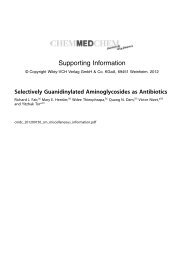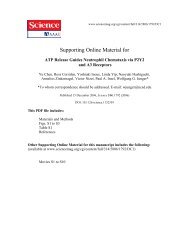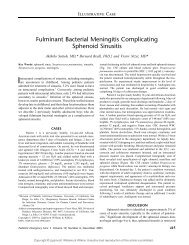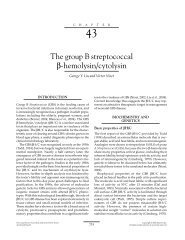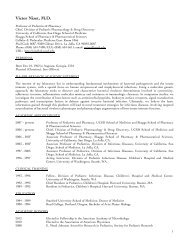BACTERIAL SEPSIS AND MENINGITIS - Nizet Laboratory at UCSD
BACTERIAL SEPSIS AND MENINGITIS - Nizet Laboratory at UCSD
BACTERIAL SEPSIS AND MENINGITIS - Nizet Laboratory at UCSD
Create successful ePaper yourself
Turn your PDF publications into a flip-book with our unique Google optimized e-Paper software.
Birth Weight<br />
The factor associ<strong>at</strong>ed most significantly with enhanced<br />
risk for bacterial sepsis and meningitis in neon<strong>at</strong>es is low<br />
birth weight (see Tables 6–5 and 6–9) [12,18,270–272].<br />
Infection is the most common cause of de<strong>at</strong>h in infants<br />
with very low birth weight [271,272]. With the exception<br />
of infection caused by GBS, it is unusual for a term infant<br />
to develop early-onset sepsis after an uneventful pregnancy<br />
and delivery. In a study in England and Wales,<br />
neon<strong>at</strong>es weighing less than 2000 g <strong>at</strong> birth acquired<br />
meningitis six times more frequently than infants weighing<br />
more than 2000 g [26]. The lower the infant’s birth<br />
weight, the higher is the incidence of sepsis (see<br />
Table 6–5). An Israeli study of 5555 very low birth weight<br />
infants documented the increased risk of l<strong>at</strong>e-onset sepsis<br />
with decreasing birth weight; l<strong>at</strong>e-onset sepsis occurred in<br />
16.8% of neon<strong>at</strong>es with a birth weight of 1250 to 1500 g,<br />
30.6% of neon<strong>at</strong>es weighing 1000 to 1249 g, 46.4% of<br />
neon<strong>at</strong>es weighing 750 to 999 g, and 53% of neon<strong>at</strong>es<br />
weighing less than 750 g <strong>at</strong> birth [16]. In a study of infants<br />
in Atlanta (see Table 6–9), the importance of birth weight<br />
was identified as a predisposing factor for development of<br />
early-onset and l<strong>at</strong>e-onset sepsis. If very low birth weight<br />
infants survived the first days of life, r<strong>at</strong>es of sepsis<br />
decreased, but remained elev<strong>at</strong>ed [267]; 16% of 2416<br />
infants with birth weights of 501 to 1500 g who were<br />
enrolled in a study sponsored by NICHD developed<br />
sepsis <strong>at</strong> a median of 17 days of age [18].<br />
Risk Factors of Infant and Mother<br />
The rel<strong>at</strong>ive importance of other factors associ<strong>at</strong>ed with<br />
systemic infection in the newborn is more difficult to<br />
define. In their prospective study of 229 infants with sepsis<br />
and meningitis, Greenberg and coworkers [12] found<br />
th<strong>at</strong> certain conditions were common: 130 (57%) were<br />
prem<strong>at</strong>ure (24 hours) interval after<br />
rupture of m<strong>at</strong>ernal membranes. Investig<strong>at</strong>ors in Pakistan<br />
[273] found th<strong>at</strong> m<strong>at</strong>ernal urinary tract infection, m<strong>at</strong>ernal<br />
fever, vaginal discharge, and vaginal examin<strong>at</strong>ions<br />
during labor were m<strong>at</strong>ernal factors significantly associ<strong>at</strong>ed<br />
with neon<strong>at</strong>al early-onset sepsis, whereas low Apgar<br />
scores <strong>at</strong> birth and the need for endotracheal intub<strong>at</strong>ion<br />
were significant neon<strong>at</strong>al risk factors.<br />
Attack r<strong>at</strong>es for early-onset group B streptococcal sepsis<br />
in a study from Chicago [274] were affected by birth<br />
weight, dur<strong>at</strong>ion of rupture of membranes, and occurrence<br />
of m<strong>at</strong>ernal peripartum fever. Infants with one or<br />
more of these perin<strong>at</strong>al risk factors had an <strong>at</strong>tack r<strong>at</strong>e of<br />
8 per 1000 live births and a mortality r<strong>at</strong>e of 33% compared<br />
with infants without such risk factors, who had an<br />
<strong>at</strong>tack r<strong>at</strong>e of 0.6 per 1000 live births and a mortality r<strong>at</strong>e<br />
of 6% (Table 6–10).<br />
M<strong>at</strong>ernal fever during labor or after delivery suggests a<br />
concurrent infectious event in the mother and infant, but<br />
noninfectious events may be responsible for m<strong>at</strong>ernal<br />
fever. Use of epidural analgesia for pain relief during<br />
labor is associ<strong>at</strong>ed with increases in m<strong>at</strong>ernal temper<strong>at</strong>ure.<br />
TABLE 6–10 Rel<strong>at</strong>ionship of Attack R<strong>at</strong>es and F<strong>at</strong>alities of<br />
Neon<strong>at</strong>al Group B Streptococcal Early-Onset Disease to Perin<strong>at</strong>al<br />
Characteristics<br />
Characteristic<br />
Birth weight (g)<br />
Attack R<strong>at</strong>e<br />
per 1000<br />
Live Births<br />
Mortality<br />
R<strong>at</strong>e (%)<br />
2500 1 3<br />
Rupture of membranes (hr)<br />
48 11 33<br />
Peak intrapartum temper<strong>at</strong>ure ( C)<br />
37.5 7 17<br />
Perin<strong>at</strong>al risk factors<br />
CHAPTER 6 Bacterial Sepsis and Meningitis<br />
Present 7.6 33<br />
Absent 0.6 6<br />
Total no. infants ¼ 32.384 2 26<br />
239<br />
D<strong>at</strong>a from Boyer KM, et al. Selective intrapartum chemoprophylaxis of neon<strong>at</strong>al group B<br />
streptococcal early-onset disease, I: epidemiologic r<strong>at</strong>ionale. J Infect Dis 148:795-801, 1983.<br />
Intrapartum fever of more than 38 C (>100.4 F)<br />
occurred an average of 6 hours after initi<strong>at</strong>ion of epidural<br />
anesthesia in 14.5% of women receiving an epidural anesthetic<br />
compared with 1% of women not receiving an epidural<br />
agent; the r<strong>at</strong>e of fever increased from 7% in<br />
women with labors of less than 6 hours to 36% in women<br />
with labors lasting longer than 18 hours. There was no<br />
difference in the incidence of neon<strong>at</strong>al sepsis in the<br />
infants born to 1045 women who received epidural analgesia<br />
(0.3%) compared with infants born to women who<br />
did not have epidural analgesia (0.2%) [275]. Fetal core<br />
temper<strong>at</strong>ure may be elev<strong>at</strong>ed during m<strong>at</strong>ernal temper<strong>at</strong>ure<br />
elev<strong>at</strong>ion, and increased temper<strong>at</strong>ure may be present<br />
transiently in the neon<strong>at</strong>e after delivery.<br />
Ethnicity<br />
The Collabor<strong>at</strong>ive Perin<strong>at</strong>al Research Study provides<br />
historical inform<strong>at</strong>ion on 38,500 pregnancies [276];<br />
selected d<strong>at</strong>a for white and black women are presented<br />
in Table 6–11. Black women had a higher r<strong>at</strong>e of prem<strong>at</strong>ure<br />
rupture of membranes lasting more than 24 hours<br />
(21.4%) compared with white women (10.8%), black<br />
women had a higher r<strong>at</strong>e of puerperal infection (4.1%)<br />
compared with white women (3.6%), and more black<br />
infants weighed less than 2500 g <strong>at</strong> birth (13.4%) compared<br />
with white infants (7.1%). More recent published<br />
d<strong>at</strong>a concur with the d<strong>at</strong>a observed 30 years ago. The<br />
N<strong>at</strong>ional Center for Health St<strong>at</strong>istics reported continued



